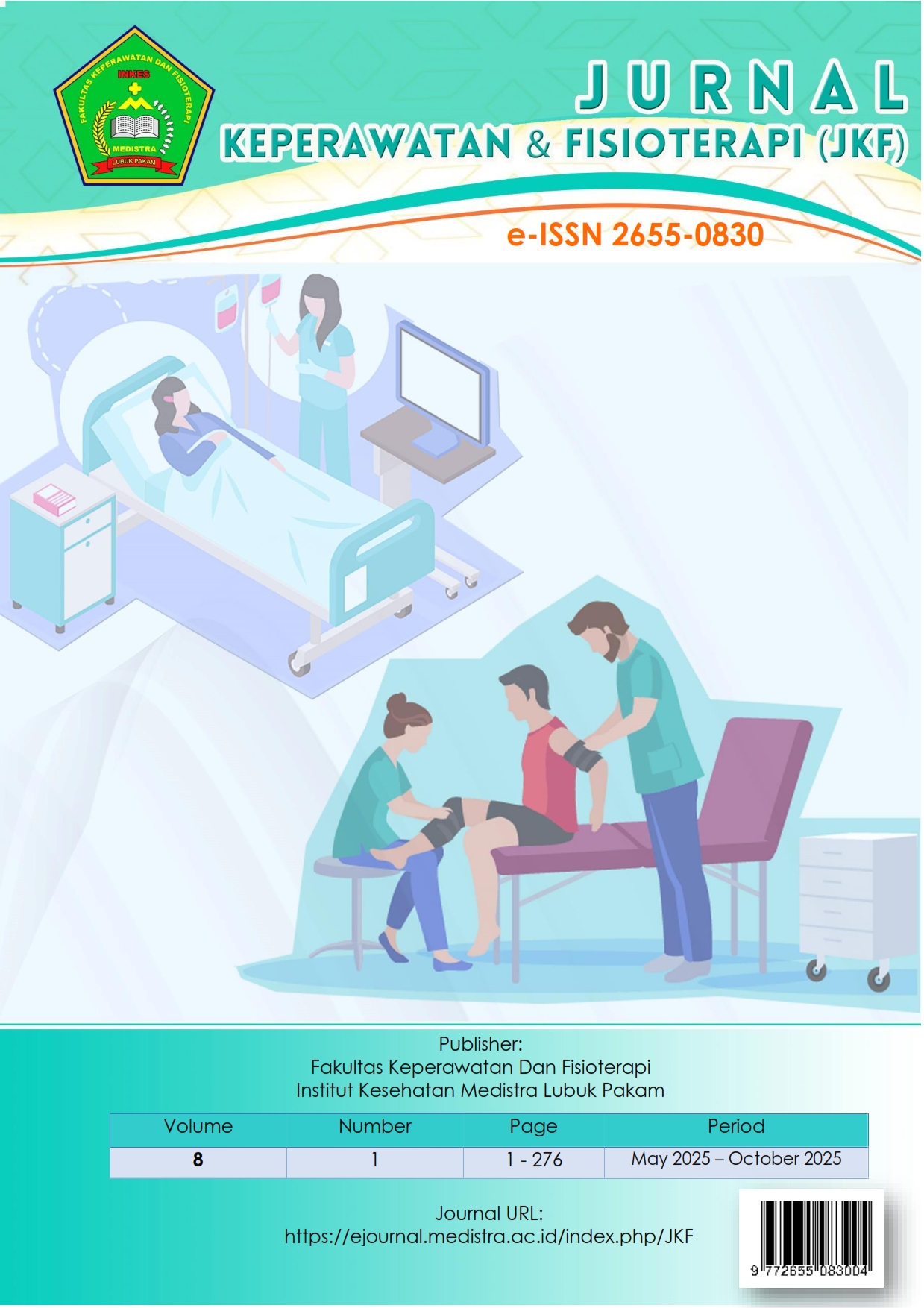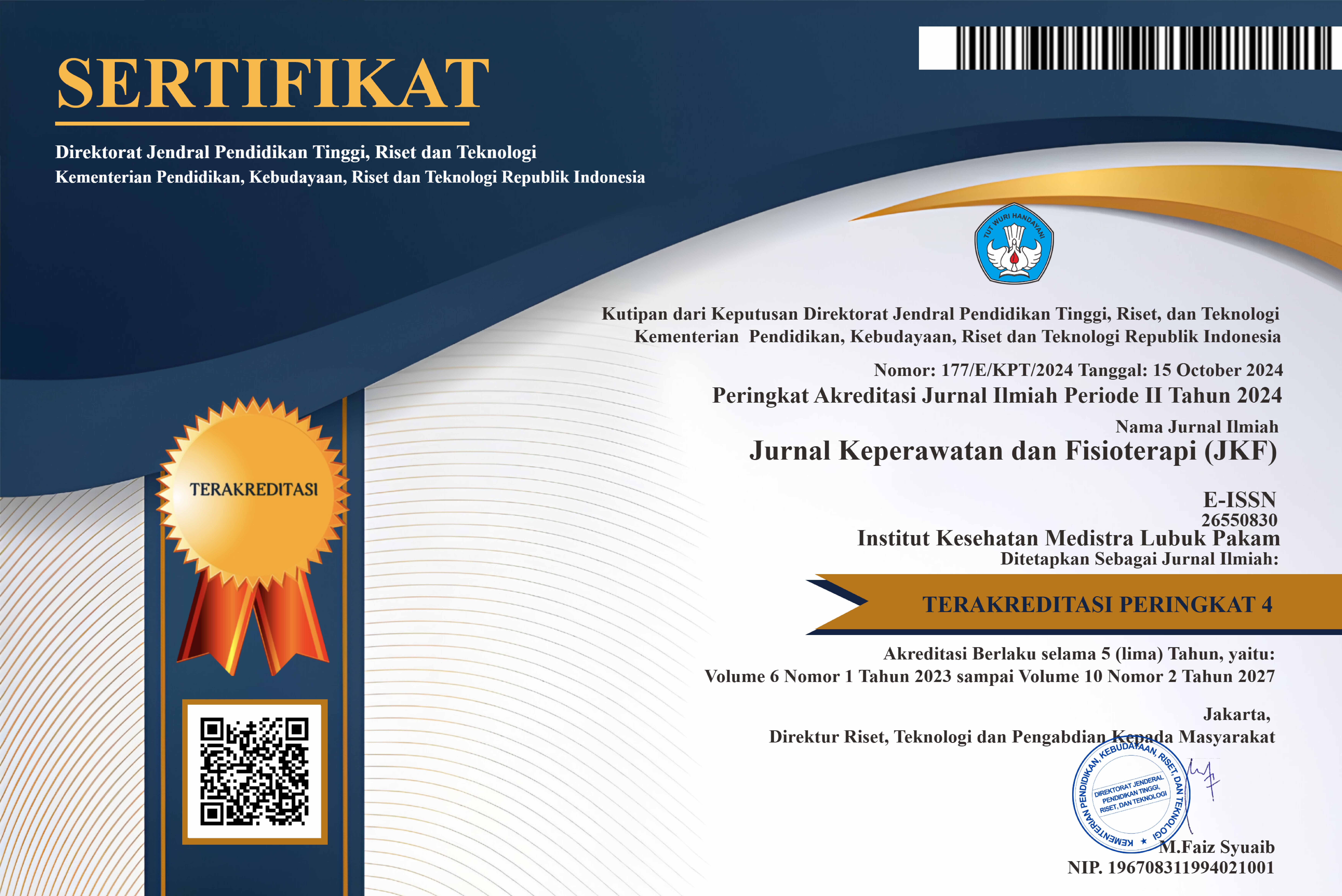The Relationship Between Nurse Response Time In Treating Open Fractur Patients And The Risk Of Hypovolemic Shock In The Emergency Room Of Grandmed Hospital Lubuk Pakam
DOI:
https://doi.org/10.35451/kxsgpw35Keywords:
Nurse response time, open fractures, hypovolemic shockAbstract
Introduction:
Open fractures are bone injuries involving skin disruption, leading to direct bone exposure and a high risk of contamination. Emergency care reports indicate that around 50% of trauma patients die en route to the hospital, 35% due to severe injuries. Timely nursing response is crucial in early emergency management, especially in open fractures. This study aimed to assess the association between nurses' response time and the risk of hypovolemic shock in patients with open fractures. Methods:
A descriptive correlational study was conducted from September to October 2024 at the Emergency Department of Grandmed Hospital, Lubuk Pakam. Thirty-one nurses were selected using total sampling. Data were obtained through structured observations of eligible nurses. Results: Delayed response was observed in 32.3% of nurses, with hypovolemic shock occurring in 32.3% of patients. Fisher’s Exact Test revealed a significant association between nursing response time and hypovolemic shock risk (p = 0.040). Discussion: Delayed nursing interventions were significantly linked to increased hypovolemic shock risk. The findings underscore the need for effective leadership and prompt nursing action to prevent complications.
Downloads
References
[1] Silvya Dwi Yanti, Syifa Fujianti (2024). Gangguan Muskuloskeletal pada Perawat di Rumah Sakit: Suatu Tinjauan Literatur. Holistik Jurnal Kesehatan.
[2] Rara Adril, Jaslis Ilyas (2024). Faktor – faktor yang mempengaruhi waktu tanggap (Response Time) Tenaga Kesehatan Pada Penanganan Pasien Di Instalasi Gawat Darurat (IGD) Rumah sakit: Literaturereview. Jurnal Kesehatan Masyarakat.
[3] Laporan Survei Kesehatan Indonesia (SKI) 2023. https://layanandata.kemkes.go.id/katalog-data/ski/ketersediaan-data/ski-2023
[4] Renny Kornia (2020) Hubungan Metode Triase Emergency Severity Index (ESI) Dengan Length of stay (LOS) di IGD RS SINGAPARNA TASIKMALAYA
[5] Katayama Y, Kitamura T, Kiyohara K, Iwami T, Kawamura T, Hayashida S, et al. Factors associated with the difficulty in hospital acceptance at the scene by emergency medical service. Diakses pada 24 Agustus 2022 Pukul : 17.00
[6] Ali, A., Ifadah, E., & Hidayah, N. (2024). Buku Ajar Keperawatan Gawat Darurat oleh. Diterbitkan oleh PT. Sonpedia Publishing Indonesia
[7] Adril, R., & Ilyas, J. (2024). Faktor-Faktor yang Mempengaruhi Waktu Tanggap (Response Time) Tenaga Kesehatan pada Penanganan Pasien di Instalasi Gawat Darurat (IGD): Literature Review. https://journal.universitaspahlawan.ac.id/index.php/prepotif/article/view/38855
[8] Standl, T., Annecke, T., Cascorbi, I., Heller, A. R., Sabashnikov, A., & Teske, W. (2018). The nomenclature, definition and distinction of types of shock. Deutsches Ärzteblatt International, 115(45), 757–768. https://doi.org/10.3238/arztebl.2018.0757
[9] Karokaro, T. M., Hayati, K., Sitepu, S. D. E. U., & Sitepu, A. L. (2020). Faktor €“Faktor Yang Berhubungan Dengan Waktu Tanggap (Response Time) Pasien Di Instalasi Gawat Darurat Rumah Sakit Grandmed. Jurnal Keperawatan dan Fisioterapi (JKF), 2(2), 172-180.
[10] Sukamto, F. I. (2021). Gambaran response time pasien di IGD RSI Siti Aisyah Madiun. Journal of Nursing Invention, 2(1), 29–33. https://doi.org/10.33859/jni.v2i1.72
[11] Afifah, R., Wreksagung, H., & Sari, R. P. (2022). Hubungan Beban Kerja dengan Response Time pada Penanganan Pasien di Instalasi Gawat Darurat. https://nusantarahasanajournal.com/index.php/nhj/article/view/234
[12] Riris Andriati, Dedi Trisutrisno (2023). Pengaruh resusitasi cairan terhadap status hemodinamik mean arterial pressure (map) pada pasien syok hipovolemik di igd rsud balaraja. THE JOURNAL OF Medical Surgical Concern.
[13] M. Hadriyan Akbar Arief, Bambang Eko Subekti (2023). Tatalaksana syok hipovolemik pada perdarahan akut. https://jurnal.globalhealthsciencegroup.com/index.php/JPPP/article/view/1929/1519.
[14] Silaban, J. (2024). Prosedur tindakan keperawatan medikal bedah. Getpress Indonesia.
[15] HY Safitri · 2024 — Ilmu Dasar. Keperawatan Anak. 1st ed. Mulyasari DW, editor. Sukoharjo: Pradini.
[16] Nisa, F.N., Kurnianto, E. dan Sutopo (2022). Penatalaksanaan Kegawatdaruratan Syok dengan Pendekatan. Proses Keperawatan. UB Press, Indonesia.
[17] Nurcholis1, Hudinoto Eko Y2 , Suparjo (2022). Respon time perawat dalam penanganan pasien di instalasi gawat darurat rsud kardinah kota tegal. Jurnal Update Keperawatan. https://www.semanticscholar.org/reader/c74073360ffd705e461692594b07904ef149bb89
[18] Eka Fitriyani1, Fadli2, Erni Ekasari3, Dewi Hastuty (2025). Analisis faktor yang mempengaruhi respons time perawat dalam penanganan pasien di igd rsud sawerigading palopo. Jurnal Ilmiah Kesehatan Diagnosis Volume 20 Nomor 1.
[19] Ringu, Y. T. (2024). Analisis Faktor Yang Berhubungan Dengan Response Time Perawat di IGD RSU Tipe C di Kupang.
[20] Novita, N., Marlia, I. and Heriana, S. (2023) 'Analisis Faktor-Faktor yang. Mempengaruhi Waktu Tunggu Pasien di Instalasi Gawat Darurat (IGD)
Downloads
Published
Issue
Section
License
Copyright (c) 2025 Tati Murni Karokaro, Amy Vivi Insani Alja

This work is licensed under a Creative Commons Attribution 4.0 International License.
Copyright in each article is the property of the Author.


























